To mark the 10th anniversary of the delivery of the first Qantas A380 in September 2008, today’s Throwback Thursday (TBT) features are republished from our November 2008 issue’s indepth coverage of the arrival of the first of the Flying Kangaroo’s super jumbos.

The Qantas A380 era began when the first of its double-decker giants, VH-OQA Nancy-Bird Walton, touched down at Sydney Airport at 9am on September 21.
That historic landing marked the end of an eight year wait for the most anticipated commercial aircraft in decades. The A380 is the world’s biggest, most spacious, most fuel efficient airliner per seat, so its delivery to Qantas and planned entry into service on October 20 is truly a big deal. This is without doubt the most significant development for Qantas’s long haul operations since the delivery of the airline’s first 747 back in 1971. Although two years late, for the economic and competitive advantages it offers, for Qantas it will have been worth the wait.
“It ticked just about every box in comfort, environmental performance, yield, cost,” outgoing Qantas CEO Geoff Dixon told media in Toulouse for the Qantas A380 handover ceremony on September 19.
EIGHT YEARS IN THE MAKING
Then Qantas CEO-designate Geoff Dixon and then chairman Margaret Jackson announced Qantas’s first order for the as yet unlaunched A3XX – which would become the A380 – on November 29 2000 as part of a broader order that also included 13 A330s and six 747-400ERs. The following month Qantas then became the first airline to sign a firm contract to buy the A380 (with the Rolls-Royce Trent 900 engine selected in early 2001).
There’s no doubt that was a bold decision. The A3XX, formally launched as the A380 in December 2000, was just a paper aeroplane at the time of the Qantas announcement, and plenty of detractors doubted Airbus’s ability to build and deliver an aircraft that would meet the ambitious performance and operating economic targets the manufacturer promised.
Airbus promised to build the world’s largest airliner with seating for 555 passengers, with 20 per cent better operating costs per seat compared to the 747-400 while flying further. The financial and technological challenges were on a similar scale to the aircraft itself, and Qantas had never before ordered Airbus aircraft (its only Airbus experience coming from the four A300B4s it inherited from the merger with Australian Airlines).
And yet Qantas seemed quick to realise the potential in operating the A3XX, and the competitive disadvantage it would be put at had it not.
“It was an important, visionary decision,” Qantas executive general manager (EGM) John Borghetti told Australian Aviation.
“At the time (then CEO) James Strong I think had enormous foresight in making what was then a very bold decision, and we’re grateful that he did.”

The original order for 12 A380s and a then undisclosed number of options (since revealed to be 12) and purchase rights had come after an intensive 12 month evaluation of long haul aircraft options led by David Cox, now Qantas’s EGM engineering.
“The board and management of Qantas saw at the time the benefit of buying the world’s largest commercial aircraft,” Geoff Dixon said in his formal acceptance speech for the first aircraft.
“We recognised the operational and economic advantages that the A380 will deliver … and we certainly knew the A380 would give us the opportunity to re-invent our onboard product, consistent with our tradition of being a very, very competent long haul carrier.”
The plan in 2000 was for the first aircraft to be delivered in 2006 and the last of the 12 in 2011. Airbus’s well publicised A380 production issues put paid to that initial delivery schedule, but Qantas’s faith in the aircraft was validated by converting eight options to firm orders on October 29 2006 – just weeks after Airbus confirmed that Qantas would not get its first until August 2008, a two year delay.
“We are convinced that these problems relate to industrialisation issues at Airbus and will be remedied, and in no way relate to the technical capacity of the A380,” Dixon said at the time.
Indeed its likely Qantas saw that delay announcement as an opportunity to negotiate the follow-on order at attractive terms.
“We have negotiated an attractive ‘package’ to firm up an additional eight A380s,” Dixon said when announcing the deal. That package also included an order for four further A330-200s and financial compensation of over $200 million.
And that was on top of what would have been a very attractive deal in becoming a launch customer for the A380 in the first place. In 2000 the A380 had a list price of US$230 million, and it is generally assumed that as a launch customer Qantas would have been offered a 30 per cent plus discount on that figure, or significant discounts on the A330s it ordered at the same time.
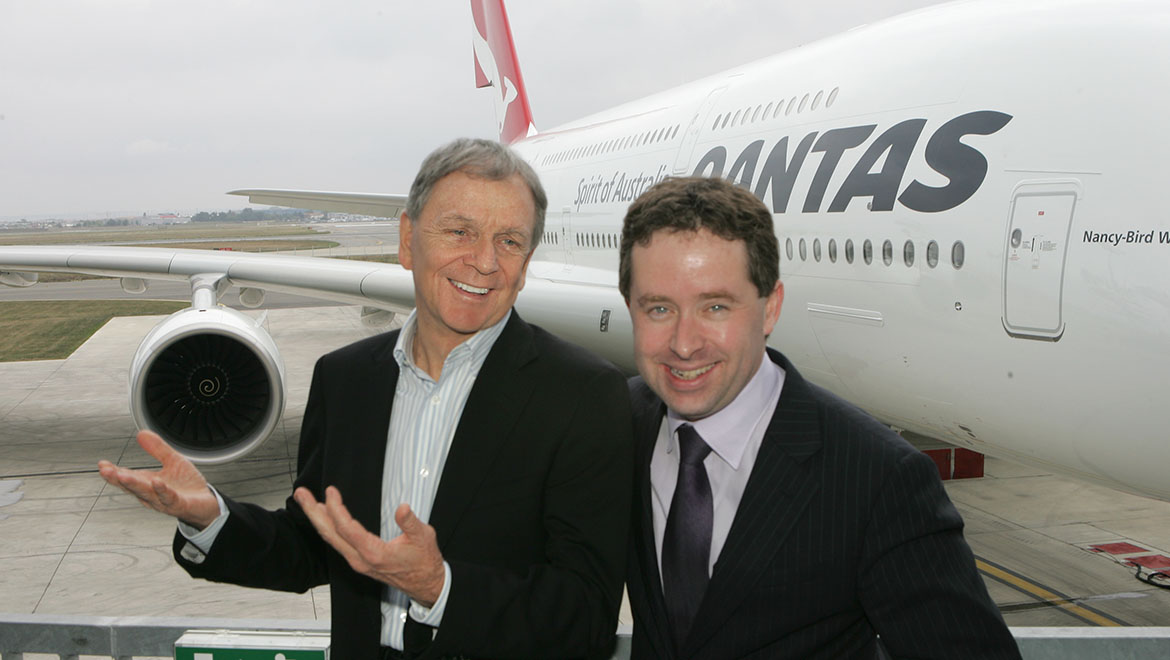
“We did ask for an A319 so we could use it as a corporate jet!” Dixon joked when Australian Aviation asked him about the terms of the original deal.
“We paid a lot of money for it, we think we got a competitive price, but the world’s full of people who think they got a competitive price.”
A lot has changed in the nearly eight years since the original order was announced. Today the A380 list price is up around US$320-330 million, while in late 2000 the Australian dollar was only in the mid 50 US cent range, and at the time or writing it was buying 20 US cents more, so in today’s terms the A380 deal would be even more attractive than at the time of contract signature in 2000.
Whatever the exact price Qantas is paying for its A380s, it’s still a very big sum of money.
“We were at dinner last night (September 18) and our CFO got a text message saying we’d just sent the funds, then around three or four minutes later Airbus got a message saying they’d received it, so I wonder who got the interest on it in the meantime!” CEO-designate Alan Joyce recalled of the process of transferring the final payment for VH‑OQA to Airbus.
VIDEO – Airbus celebrated the handover of the first Qantas A380 with this remarkable sound and light show.
“We’re happy with it,” John Borghetti said simply of the original deal.
It looks like Qantas will be taking advantage of the attractive terms of its original order again with Dixon and Joyce confirming the airline is now in talks with Airbus to firm up orders for further A380s.
“We have commenced discussions with Airbus on possibly increasing our orders for A380s,” Dixon said in Toulouse.
“We can see real reasons for us to take more A380s to allow for some growth and to replace some aircraft. That’s our belief in how good this aircraft is.”
Qantas currently has four options and purchase rights on 12 further A380s.
“For those extra 16 aircraft the price is locked in, we have delivery dates that we can exercise,” Joyce said. Qantas is not saying how many extra A380s it is considering, but it won’t be all the 16 it has options and purchase rights on.
“Not at this stage,” said Joyce.
The airline is also continuing to evaluate the 787-10 and A350-1000 as potential replacements for those 747-400s not replaced by the A380, but there is no urgent timeframe on a decision.
“Whether it’s more A380s or any other fleet type, we’re constantly evaluating different options,” Borghetti explained. “There’s no timeframe on any decision on any aircraft type. We’ll make a decision when the time is right and the climate is right.”
For now, Qantas expects to take delivery of the 20 A380s currently on order through to 2013, with the second and third aircraft due in Australia before the end of this year, and seven in service by the end of 2009, and possibly the eighth.
“By the 31st of December next year we are confident we will have seven in total, but potentially eight, “ Borghetti said, noting that the eighth aircraft is currently due to arrive in early 2010 but could be delivered by late 2009.
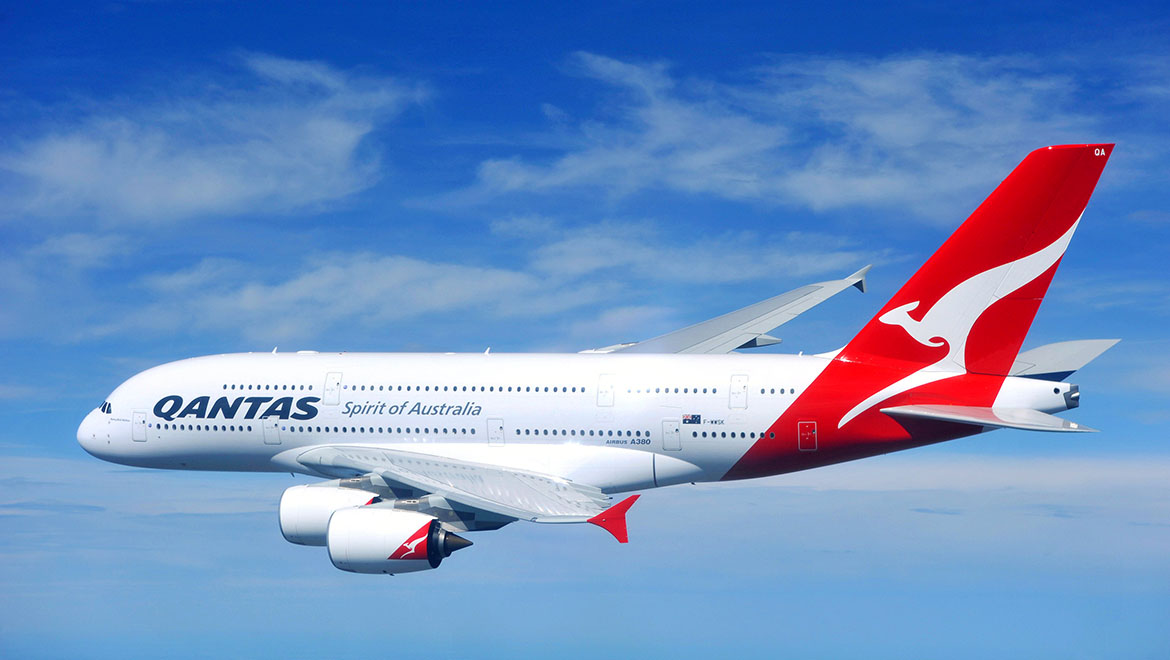
STRATEGIC IMPORTANCE
That Qantas is considering further A380s underlines the type’s importance to the airline in providing a competitive advantage over its rivals.
John Borghetti said there are two key drivers behind the A380 acquisition.
“The first is clearly an economic one,” he said. “It’s a new generation aircraft that’s more fuel efficient, 12 to 15 per cent more efficient, burns less fuel, is quieter, all the rest of it. That’s very clear. For economic reasons this is a very important strategic addition to our fleet.
“But also from a strategic positioning point of view this is very important, because it allows us to redefine and raise the bar even higher with regards to inflight product.”
The two could produce a killer combination for the airline, if Qantas can charge a premium for A380 tickets but at the same benefit from lower operating costs per seat.
Not surprisingly, Qantas won’t say what that yield premium will be, and over time that premium may decline as more airlines introduce A380s, but, said Dixon, “We will price our product, as we do now, at what we think it is worth.”
It is the A380’s extra floorspace that allows airlines to fit more spacious cabin interiors than is economically practical in smaller types so they can charge that premium. Indeed, Qantas is fitting its A380s with just 450 seats (the same number as in its about to be retired, two-class 747-300s).
Originally Airbus marketed the A380 as a 555-seater in three classes, while at the time of its original order Qantas said it planned to fit the aircraft with 524 seats. By the time of the first A380’s rollout in January 2005 the airline said it would fit its A380s with 501 seats. But now, with the introduction of a fourth class in premium economy and an expanded business class, the Qantas 450-seat configuration is the lowest seat count of any A380 configuration currently announced (Singapore Airlines’s A380s seat 471 in three classes, the Emirates A380s which will fly to Australia will seat 489 in three classes).
Those 450 seats comprise 14 first class suites in the forward cabin of the main deck, no fewer than 72 business class 80in (203cm) ‘Skybeds’ on the upper deck in a 2+2+2 configuration, behind which are the 32 premium economy seats, set at 2+3+2 with a seat pitch ranging from 38 to 42in (97 to 107cm). Most of the main deck behind first class is taken up with the 322 economy class seats (31in/79cm pitch).
So why 450 seats? “When you start the process you always start with ‘how many seats can we squeeze in’!” Borghetti joked.
“But then there’s a balance between the economics and the brand and customer experience. Our view is if you are a premium airline attracting a premium end of the market, if you have a premium product then you should be able to attract a premium price.”
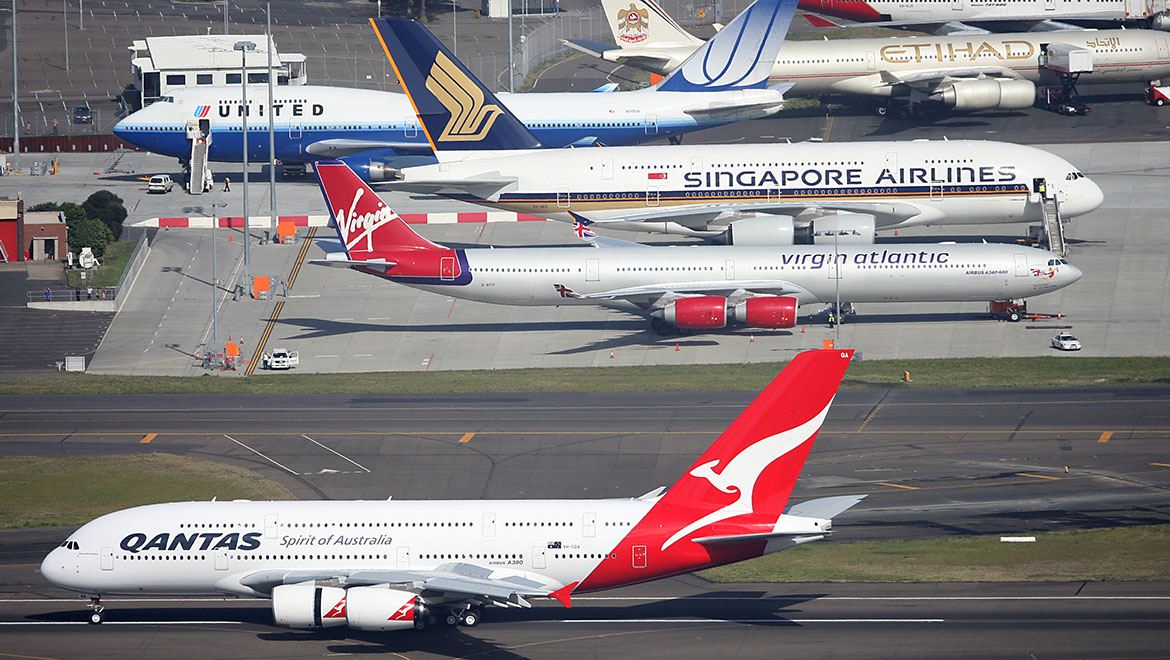
The Qantas A380’s “premium product” was developed by Australian-born designer Marc Newson, who first began working on Qantas A380 interior design five years ago.
“The importance of design I think has been understated in airlines, and I don’t know of any other in the world that has focused on design as a key attribute of its product and brand positioning as much as Qantas has,” Borghetti said.
“And why did we do that? Well we do that because I fundamentally believe that if something is pleasing to the eye it puts your mind in a more receptive state. Therefore when you are on an aircraft and you see our design and you are in a receptive state it makes the journey more enjoyable. That’s deliberate, and that’s what I think makes our A380 interior different.”
Much of the premium advantage Qantas hopes to attract will come from the 72 Skybeds, 22 more than in Qantas’s four class, 351-seat 747-400s. Premium economy and especially first class will likely attract a premium as well, but the A380 will seat the same number in these classes as does Qantas’s four class 747-400s.
Given the parlous state of the world financial system at the moment, it’s possible that any as-yet undetected softening in demand for business class travel could force Qantas to re-evaluate its A380 seat count. A Centre for Asia Pacific Aviation analysis notes, “any aircraft that is capable of carrying more passengers will eventually do so – just like the 747 before it. There is an economic gravity force that encourages higher seating density.”
It notes that, “as business markets slow, and the curiosity value of the A380 diminishes, that temptation to exploit better seat economics will necessarily grow.”
 For now though, Qantas continues to experience very strong loads on its routes and has no plans to tweak its configuration.
For now though, Qantas continues to experience very strong loads on its routes and has no plans to tweak its configuration.
“We would, if we had to,” said Borghetti.
“At this stage we have no plans in doing that, but if market conditions change, absolutely we would change it.”
If there was a prolonged downturn, another option Qantas would have is to begin withdrawing its 747-400s. But for now, even though the A380 will begin operating some 747-400 routes, there is no firm plan to begin retiring the current workhorse of the Qantas long haul fleet.
“The 747-400 is still relatively young, it’s not ready for retirement from next year, it still has some time to go,” Borghetti said. But the A380’s arrival does mean the 747‑300 ‘Classics’ can be retired by year’s end.
G’DAY LA
Still, from October 20 the 747-400 will be seen less frequently on one of its long time key runs, from Australia to Los Angeles.
The inaugural Qantas A380 service was due to be QF93 from Melbourne to Los Angeles on October 20.
“Melbourne is an important market for us and the aircraft suits the route, and someone had to be first!” Borghetti said of Melbourne being chosen for the first service.
“And Sydney follows only four days later.”
The initial schedule has the first A380 operating single Melbourne-LA (QF93/94) and Sydney-LA (QF11/12) return services each week, with more frequencies to be added when the second aircraft is delivered in late November.
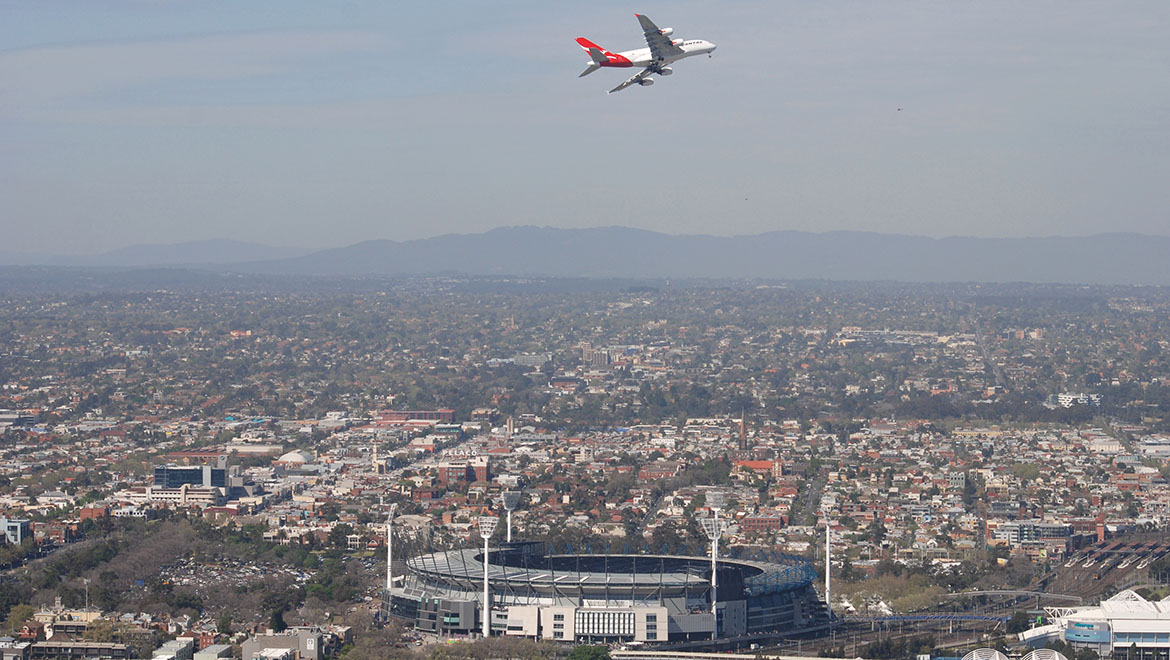
“That’s where we need the aircraft first,” Borghetti said of Los Angeles.
“Another consideration is multi-stage flying in a new aircraft. You are probably better putting it on a route that is point-to-point. That’s not the key reason why we chose LA but it is one of the things you take into account.”
Sydney to London via Singapore is the next planned A380 route, with the delivery of the third A380 by the end of 2008 allowing the inaugural QF31/QF32 A380 service to commence on January 16.
The LA and London services illustrate the near unique nature of Qantas’s long haul flying operations, and how well suited the A380 is to those routes. Both LA and London are major hubs for Qantas, there are curfew restrictions at Sydney, slot constraints at Heathrow, and there are only certain time windows for practical scheduling. All those factors mean capacity is more important than frequency of service.
“We’re unique in the world in having such a schedule that needs so many of these aircraft,” explained Alan Joyce.
Eventually all of Qantas’s London flights and most of its LA services will be operated by the 20 A380s on order. Consequently Hong Kong and Bangkok – as Qantas’s other stop-over cities for flights to London – look the most likely cities to next see Qantas A380s. That could come by the end of next year.
“At this stage we’ve locked in the northern winter schedule, we haven’t locked in the northern summer which starts from April next year, but we’re refining that at the moment and we haven’t made a decision yet,” said Borghetti.
The Qantas EGM nominates San Francisco and Frankfurt as other Qantas ports that will likely see the A380 in time. And he is confident that no matter what route the aircraft is deployed on, it will bring his airline a significant competitive advantage, particularly against airlines that don’t have A380s of their own.
“I think in every respect – the economics, the passenger comfort experience, and yield premium – it will give us a significant advantage over our opposition,” observed Borghetti.
MAKING HISTORY
VH-OQA’s arrival into Sydney offered the chance for Qantas to reflect on its achievements in introducing the A380 into service and to reflect on its history.
“I was immensely proud,” Borghetti recalled of seeing the A380 arrive in Sydney. “It was the result of a lot of work by a lot of people within Qantas.”
“Like me, everyone felt proud to see the results of their hard work, and certainly what was the subject of anticipation for quite some time,” he continued. “But I think it also heralds a display of huge investment by the company in a new modern fleet type.”
And while the airline world is a usually a hard-nosed business, most Qantas employees recognised the historical significance of the A380’s arrival.
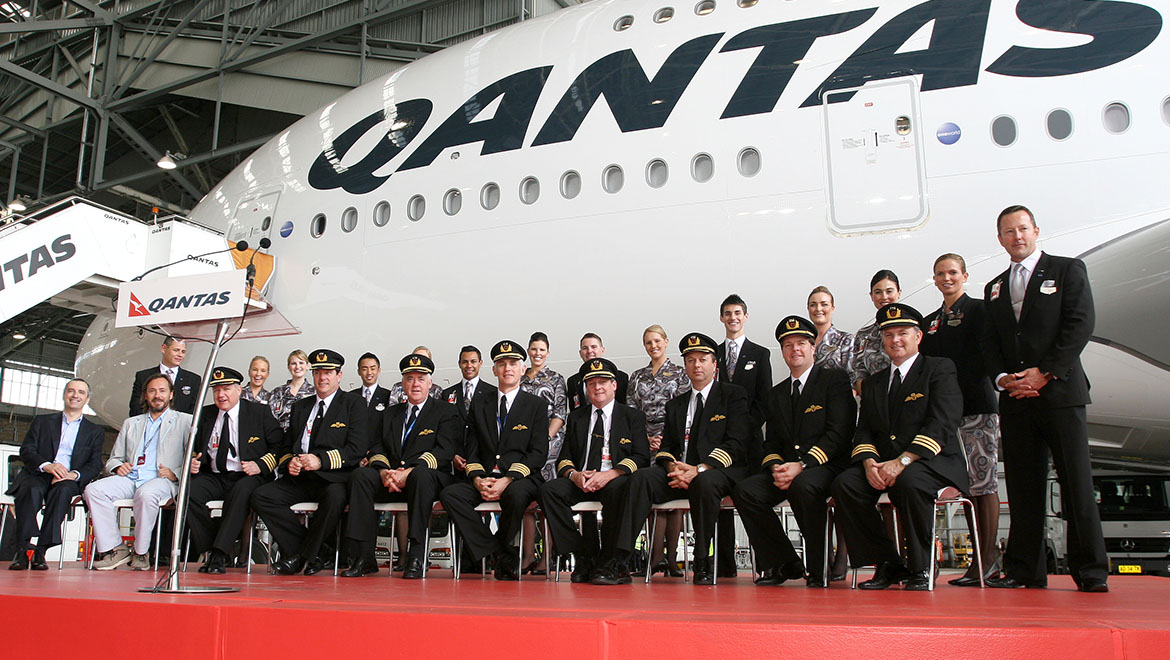
On landing in Sydney VH-OQA was towed into Hangar 96 at the Qantas Jetbase for a formal ceremony officiated by John Borghetti and attended by 3000 Qantas staff.
“I don’t think they were too many dry eyes in the hangar that morning when the choir sang I Still Call Australia Home with the aircraft as a backdrop. It was quite an emotional moment for many people.”
Borghetti remarked that the airline could have filled the hangar several times over for the arrival formalities, had there been the space. “The passion that Qantas staff have for the brand and the company comes out in situations like that, and it was a very proud moment for everyone.”
The A380 also marks another piece of Qantas history – the period from initial order to first delivery aligns neatly to Geoff Dixon’s time as CEO.
“There is also for me a bit of a historical symmetry in all this,” Dixon remarked at the delivery ceremony.
“When I signed as the Qantas representative to buy this aircraft, I was the chief executive designate, James Strong, now a member of our board, was then the CEO. And of course Alan Joyce is now the chief executive designate and he’ll take this aircraft forward.”
The A380 history theme continues with Qantas naming its A380s after Australian aviation pioneers. VH‑OQA is named after Australia’s first female pilot, Nancy-Bird Walton (Nancy these days opts to hyphenate her first and maiden names as it was a term of endearment her husband used towards her). Nancy was taught to fly by Charles Kingsford-Smith (who will also have a Qantas A380 named after him) at the age of 17.
Qantas held a naming ceremony for VH‑OQA on September 30. After a Qantas captain cracked a bottle of champagne over the A380’s nose, Nancy-Bird Walton quipped, “You better not have scratched it.”
The 92-year old aviation pioneer and her family were then treated to a quick flight in her namesake.
“It was terrific, she’s a great pioneer of Australian aviation and we are very proud to have her name on the aeroplane,” said Borghetti.
All 20 Qantas A380s will be named after Australian aviation pioneers, including Qantas founder Sir Hudson Fysh, Reg Ansett and Bert Hinkler. The full list of names is due to be announced on November 16, the airline’s 88th birthday.
It is certainly fitting that Qantas uses this history making aircraft to commemorate those Australians who have already created aviation history.
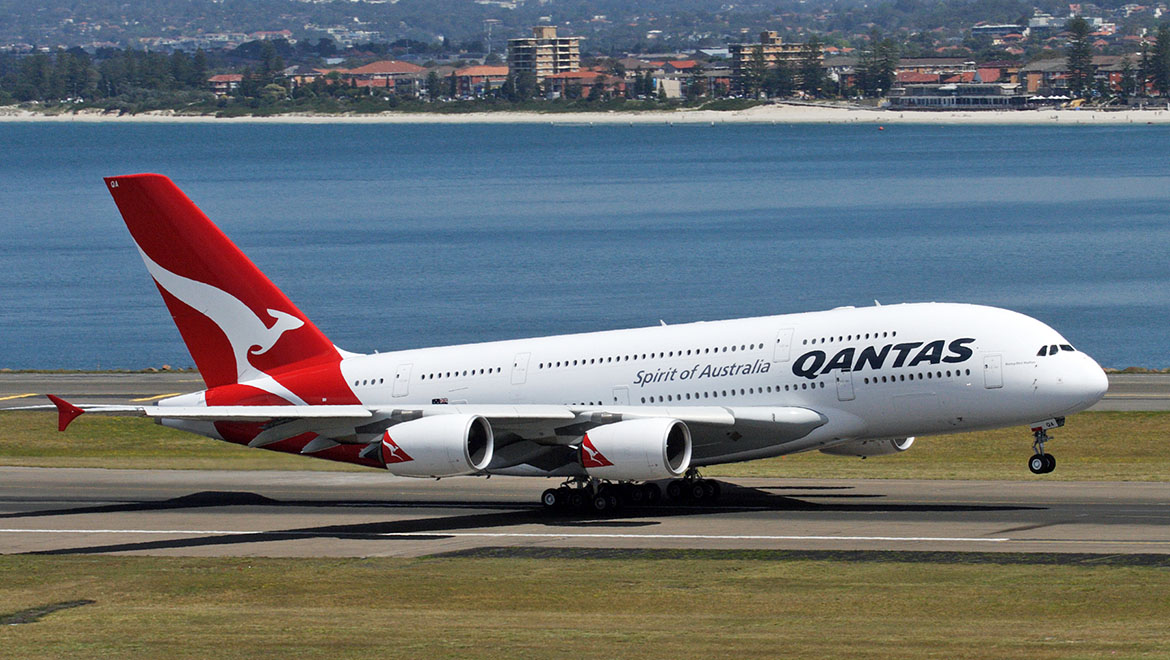
This feature article originally appeared in the November 2008 edition of Australian Aviation magazine.
To read more stories like this, subscribe here. Digital editions of the magazine can be purchased on Zinio and Issuu, or in the Apple app store.















Geoff
says:Great article Gerard. Thanks.
Well worth the wait. Congratulations to QANTAS, and the other eleven airlines that co-operated with Airbus to develop and manufacture this magnificent aircraft.
A new dawn for a new ‘Golden Age’ in aviation.
Rod Mahoney
says:Great article Gerard and lots of precious memories… Rod.
Jamie
says:Unfortunately too expensive to operate. Too much weight per seat. Too much airframe per seat. Technology several steps behind the 787.
Bill
says:Anything with more than 2 engines is out of favour with airlines now sadly. Unless ETOPS stops you from using a twin engined aircraft, there was never the market for this aircraft. Its range isn’t really big enough to be a hub buster and I’m surprised Airbus haven’t developed a high density version of the A380 like Boeing did with the 747-400D. It could work well at clogged Asian airports where slots are in high demand.
Jamie
says:Bill, I don’t think it’s the engine count that is the issue. I think it just simply does not have good enough operating costs which have nothing to do with the engine count.
Compare the basic specs of two 787-9s to a single A380. Two 787-9s mean you have 4 engines and approximately the same capacity as a single A380. Both have a similar range. Yet the MTOW of two 787-9 is over 50,000kgs lighter than a single A380 at MTOW.
Hard to compete if you’re carrying an extra 50 tonnes of dead weight.